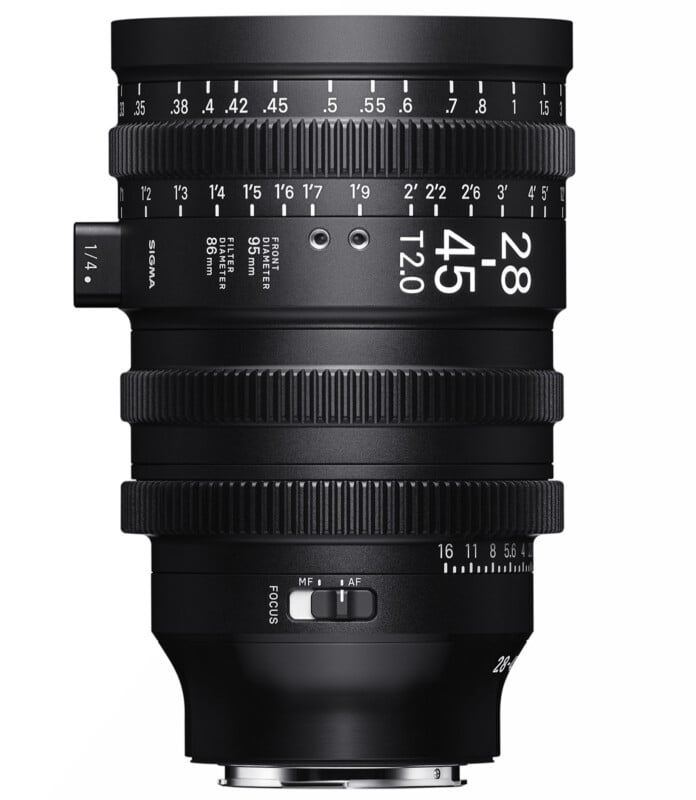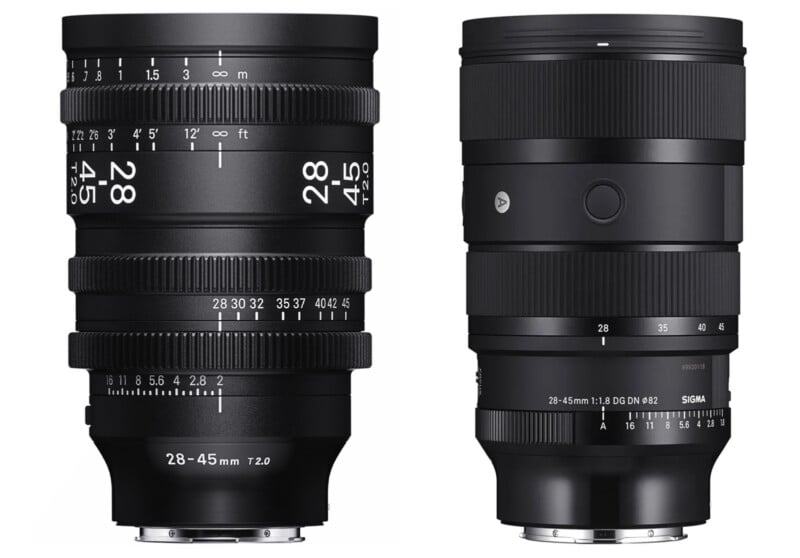![]()
In early August, Sigma announced it was making a cinema version of its 28-45mm f/1.8 Art lens, the company’s first autofocus cinema lens. Sigma also teased a reveal at IBC in Amsterdam. IBC is here, and so is the impressive new Sigma cine lens.
In its cinema-oriented transformation, the Sigma 28-45mm f/1.8 Art has become the Sigma 28-45mm T2.0 AF Cine Zoom lens, complete with HLA-type autofocus. To make the lens suited for cinema applications, Sigma gave it a focus ring with distance indicators and a click-free aperture ring for smooth adjustments. It also made the lens compatible with 95mm matte boxes.
The zoom ring rotation from 28mm to 45mm is 60 degrees, and the focus ring rotation is 200 degrees.

The L-Mount version, shown in this article, is six inches (152 millimeters) long and weighs 44.1 ounces (1,250 grams). The E-mount version is slightly longer at 6.1 inches (155 millimeters) and weighs the same as the L-mount version.
Compare that to the Sigma 28-45mm f/1.8 DG DN Art lens for L-Mount, which weighs 33.9 ounces (960 grams) and is six inches (151.4 millimeters) long. The Art lens has an 82mm front filter diameter, while the cinema lens takes 86mm filters.
Like Sigma’s other cinema lenses based on existing photo-oriented lenses, many of which are also popular with video and hybrid users, the 28-45mm T2.0 AF Cine Zoom lens will share its optical design with its photo counterpart. The most significant changes are in the design, which must be suited for cinema camera operators, many of whom use rigs and follow-focus tools.

Looking at the two versions of the Sigma 28-45mm side by side, some other differences are immediately evident. The photo version has markings for 28mm, 35mm, 40mm, and 45mm on its zoom ring, while the cine version has markings at 28mm, 30mm, 32mm, 35mm, 37mm, 40mm, 42mm, and 45mm — four additional marked focal lengths.
The aperture ring looks similar, aside from the move from a clicked to de-clicked design, although the cinema lens doesn’t have an automatic aperture position.
As mentioned earlier, the cinema lens has distance indicators on its focus ring — and a lot of them, at that. The measurements are noted in metric and imperial.
There is still no word on price or availability, and Sigma maintains that the 28-45mm T2.0 seen here and to IBC attendees is technically a prototype, albeit one that looks ready for release. Sigma’s cine lenses are well regarded in the industry, so its first autofocus-equipped cine lens is poised to land with high expectations.
Image credits: Sigma
